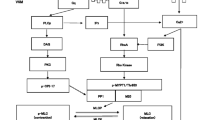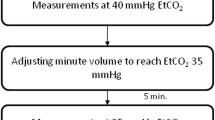Abstract
Purpose
The vascular response to anesthetics is altered in hypertensive patients since the functional and structural integrities of vascular smooth muscle and endothelium are deranged. The effects of anesthetics on angiotensin II (Ang ll)-induced changes in vascular tone are not well understood. We investigated the effects of sevoflurane and isoflurane on Ang II-induced vasoconstriction in spontaneously hypertensive rats (SHR).
Methods
The dose-dependent effects of sevoflurane and isoflurane on the Ang II-induced contraction of aortic rings, in the presence and absence of an intact endothelium, were investigated in normotensive Wistar-Kyoto rats (WKY) and SHR and compared using isometric force transducers.
Results
Ang II (10−9-10−6 M) induced a similar transient phasic contraction of endothelium-intact rings from the two rat strains in a dose-dependent manner. Removal of the endothelium augmented the Ang II-elicited phasic contraction, to a greater extent in the SHR group than in the WKY group. Sevoflurane and isoflurane (1–3 minimum alveolar concentration) concentration-dependently inhibited the Ang II-induced contraction of endothelium-intact rings from WKY; an effect that was greatly enhanced following removal of the endothelium. Agreater degree of attenuation of the Ang II-induced contraction of both endothelium-intact and -denuded rings by the two anesthetics was observed in the SHR group. The inhibitory effects of isoflurane on the Ang II-induced contraction of aortic rings from both strains appeared to be stronger than that of sevoflurane at equipotent concentrations.
Conclusion
Our finding that the inhibitory effects of isoflurane and sevoflurane on Ang II-induced vasoconstriction are enhanced in SHR may, at least in part, account for the anesthesia-induced systemic hypotension frequently seen in hypertensive patients.
Résumé
Objectif
La réponse vasculaire aux anesthésiques est modifiée chez les patients hypertendus, car l’intégrité fonctionnelle et structurale des muscles lisses vasculaires et de l’endothélium est perturbée. Les effets des anesthésiques sur les changements de tonus vasculaire induits par l’angiotensine II (Ang II) ne sont pas très bien compris. Nous avons exploré les effets du sévoflurane et de l’isoflurane sur la vasoconstriction induite par l’Ang II chez des rats spontanément hypertendus (PSH).
Méthode
Les effets reliés à la dose du sévoflurane et de l’isoflurane sur la contraction d’anneaux aortiques induite par l’Ang II, en présence et en l’absence d’un endothélium intact, ont été examinés chez des rats Wistar-Kyoto (WKY) normotendus et RSH et comparés en utilisant des transducteurs de force isométrique.
Résultats
L’Ang II (10−9-10−6 M) a induit une contraction phasique transitoire, dépendante de la dose, des anneaux intacts d’endothélium prélevés chez les deux souches de rats. Le retrait de l’endothélium a augmenté la contraction phasique induite par l’Ang II, davantage dans le groupe RSH que dans le groupe WKY. Le sévoflurane et l’isoflurane (de concentration alvéolaire minimale de 1–3) ont inhibé la contraction induite pas l’Ang II des anneaux intacts d’endothélium de WKY en fonction de la concentration. C’est un effet qui a été grandement accru à la suite du retrait de l’endothélium. Une plus importante atténuation de la contraction induite par l’Ang II des anneaux dénudés et des anneaux intacts d’endothélium par les deux anesthésiques a été observée dans le groupe RSH. Les effets inhibiteurs de l’isoflurane sur la contraction des anneaux aortiques des deux souches induite par l’Ang II sont apparus plus prononcés que ceux du sévoflurane pour des concentrations équivalentes.
Conclusion
Notre résultat voulant que les effets inhibiteurs de l’isoflurane et du sévoflurane sur la vasoconstriction induite par l’Ang II soient accrus chez les RSH peut, au moins en partie, expliquer l’hypotension générale induite par l’anesthésie observée chez les patients hypertendus.
Similar content being viewed by others
References
Touyz RM, Schiffrin EL. Signal transduction mechanisms mediating the physiological and pathophysiological actions of angiotensin II in vascular smooth muscle cells. Pharmacol Rev 2000; 52: 639–72.
Boulanger CM, Caputo L, Lévy BI. Endothelium AT1-mediated release of nitric oxide decreases angiotensin II contractions in rat carotid artery. Hypertension 1995; 26: 752–7.
Schiffrin EL. Intracellular signal transduction for vasoactive peptides in hypertension. Can J Physiol Pharmacol 1994; 72: 954–62.
Bodin P, Travo C, Stockt JC, Travo P. High sensitivity of hypertensive aortic myocytes to norepinephrine and angiotensin. Am J Physiol 1993; 264: C441–5.
Neusser M, Tepel M, Zidek W. Angiotensin II responses after protein kinase C activation in vascular smooth muscle cells of spontaneously hypertensive rats. J Cardiovasc Pharmacol 1993; 21: 749–53.
Wilkie N, Ng LL, Boarder MR. Angiotensin II responses of vascular smooth muscle cells from hypertensive rats: enhancement at the level of p42 and p44 mitogen activated protein kinase. Br J Pharmacol 1997; 122: 209–16.
Smith DH. Treatment of hypertension with an angiotensin II-receptor antagonist compared with an angiotensin-converting enzyme inhibitor: a review of clinical studies of telmisartan and enalapril. Clin Ther 2002; 24: 1484–501.
Côrtes SF, Lentos VS, Corriu C, Stockt JC. Changes in angiotensin II receptor density and calcium handling during proliferation in SHR aortic myocytes. Am J Physiol 1996; 271: H2330–8.
Dohi Y, Thiel MA, Bühler FR, Lüscher TF. Activation of endothelial L-arginine pathway in resistance arteries. Effect of age and hypertension. Hypertension 1990; 15: 170–9.
Dohi Y, Hahn AW, Boulanger CM, Bühler ER, Lüscher TE. Endothelin stimulated by angiotensin II augments contractility of spontaneously hypertensive rat resistance arteries. Hypertension 1992; 19: 131–7.
Su JY, Tang LJ. Effects of halothane on the sarcoplasmic reticulum Ca2+ stores and contractile proteins in rabbit pulmonary arteries. Anesthesiology 1998; 88: 1096–106.
Toda H, Su JY. Mechanisms of isoflurane-increased sub-maximum Ca2+-activated force in rabbit skinned femoral arterial strips. Anesthesiology 1998; 89: 731–40.
Su JY, Vo AC. Role of PKC in isoflurane-induced biphasic contraction in skinned pulmonary arterial strips. Anesthesiology 2002; 96: 155–61.
Akata T, Lzumi K, Nakashima M. The action of sevoflurane on vascular smooth muscle of isolated mesenteric resistance arteries (part 2). Mechanisms of endothelium-independent vasorelaxation. Anesthesiology 2000; 92: 1441–53.
Yu J, Ogawa K, Tokinaga Y, Hatano Y. Sevoflurane inhibits guanosine 5′-[γ-thio]triphosphoate-stimulated, Rho/Rho-kinase-mediated contraction of isolated rat aortic smooth muscle. Anesthesiology 2003; 99: 646–51.
Pili-Floury S, Samain E, Bouillier H, et al. Etomidate alters calcium mobilization induced by angiotensin II in rat aortic smooth muscle cells. J Cardiovasc Pharmacol 2004; 43: 485–8.
Nakamura K, Terasako K, Toda H, et al. Mechanisms of inhibition of endothelium-dependent relaxation by halothane, isoflurane, and sevoflurane. Can J Anaesth 1994; 41: 340–6.
Izumi K, Akata T, Takahashi S. The action of sevoflurane on vascular smooth muscle of isolated mesenteric resistance arteries (part 1). Role of endothelium. Anesthesiology 2000; 92: 1426–40.
Samain E, Bouillier H, Kucker-Martin C, et al. Isoflurane alters angiotensin II-induced Ca2+ mobilization in aortic smooth muscle cells from hypertensive rats. Implication of cytoskeleton. Anesthesiology 2002; 97: 642–51.
Yu J, Tokinaga Y, Ogawa K, Iwahashi S, Hatano Y. Sevoflurane inhibits angiotensin II-induced, protein kinase C-mediated but not Ca2+-elicited contraction of rat aortic smooth muscle. Anesthesiology 2004; 100: 879–84.
Samain E, Glichet A, Bouillier H, et al. Propofol differently alters vascular reactivity in normotensive and hypertensive rats. Clin Exp Pharmacol Physiol 2002; 29: 1015–7.
Samain E, Bouillier H, Marty J, Safar M, Dagher G. The effect of propofol on angiotensin II-induced Ca2+ mobilization in aortic smooth muscle cells from normotensive and hypertensive rats. Anesth Analg 2000; 90: 546–52.
Torri G, Casati A. Cardiovascular homeostasis during inhalational general anesthesia: a clinical comparison between sevoflurane and isoflurane. On behalf of the Italian Research Group on Sevoflurane. J Clin Anesth 2000; 12: 117–22.
Nathan N, Vial G, Benrhaiem M, Peyclit A, Feiss P. Induction with propofol target-concentration infusion vs. 8% sevoflurane inhalation and alfentanil in hypertensive patients. Anaesthesia 2001; 56: 251–7.
Author information
Authors and Affiliations
Corresponding author
Additional information
Source of financial support: This research was supported in part by grant-in-aid No. 13470327 and No. 13671607 for Scientific Research from the Ministry of Education, Science, Sports and Culture of Japan.
Rights and permissions
About this article
Cite this article
Yu, J., Ogawa, K., Tokinaga, Y. et al. The vascular relaxing effects of sevoflurane and isoflurane are more important in hypertensive than in normotensive rats. Can J Anesth 51, 979–985 (2004). https://doi.org/10.1007/BF03018483
Accepted:
Published:
Issue Date:
DOI: https://doi.org/10.1007/BF03018483




